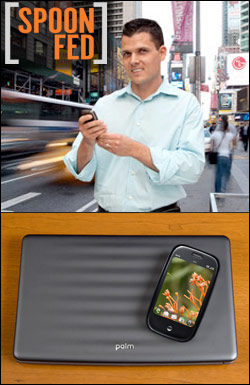Hey Palm, Bring Back the Foleo!
At the moment things aren't looking great for Palm, the company ex-Apple exec Jon Rubinstein seemingly resuscitated when he introduced the groundbreaking webOS at the beginning of 2009. Sales for the Pixi and Pre Plus at Verizon Wireless have been below expectations, and the company's stock plummeted by 19 percent yesterday after the news hit that Palm was cutting its revenue forecast. In a letter to his employees, Rubinstein laid the blame for Palm's lackluster performance on the Verizon Wireless launch execution, going on to say that the combination of better sales rep training and a marketing blitz would turn things around. I say Palm needs to think bigger. Much bigger.
About a year ago I made the case for a webOS-powered netbook. Now that I've tried one of the first Windows 7 touch notebooks and have played with many of the Android-based tablets and netbooks coming to market, I think Palm should try to leverage its OS in a device that's an evolved version of the Foleo, the 10-inch smart phone companion the company killed before bringing it to market. I'm not saying this move will save the company, but I do believe Palm could certainly compete against the likes of Notion Ink and JooJoo, which have virtually no brand recognition beyond geeks like me.
In some ways webOS is better suited for a larger screen than a traditional smart phone. The activity card interface makes it easy to multitask, and it provides a great web browsing experience. Plus, Flash support is imminent, and I'd much rather stream Hulu on a 10-inch screen than a 3.1-inch one. I'm not saying Palm shouldn't be working on phones with supersized displays like everyone else, but that's the point. Everyone else is doing that, and the iPad's only big-name competitor thus far is the HP Slate.
By dint of its size, a newfangled Foleo would also be able to accommodate a larger battery. And that's one of my biggest complaints about webOS. It's always on and always connected, just as so-called smartbooks are supposed to be, but it doesn't have the endurance to back it up. Palm would also presumably be able to stuff a faster processor inside this device, which would address some of the latency issues webOS has on the smart phone side.
So what about apps? Yes, Palm is playing catch up, but a Foleo 2 would mitigate some of that criticism because consumers would be more likely to use web apps. And having Flash support would help here as well. Lenovo has a great-looking smartbook coming out in the Skylight that also will rely on web apps, but it's a homegrown Linux OS and the device doesn't support touch. If Palm moved sooner than later, it would also be able to have an answer ready for Chrome OS-based netbooks coming to market by the end of the year. They, too, will highlight web apps, but you basically live inside the browser, which will be boring for some. webOS is just more dynamic.
At a time when people are warming to the idea of tablets (and potentially smartbooks), Palm has an opportunity to be a pioneer in a market that's not even close to mature. The original Foleo was ahead of its time. The time is now for a Foleo 2.
Editor in Chief Mark Spoonauer directs LAPTOP’s online and print editorial content. He has been covering mobile and wireless technology for more than a decade. Read his weekly SpoonFed column at www.laptopmag.com/spoonfed.
Sign up to receive The Snapshot, a free special dispatch from Laptop Mag, in your inbox.


